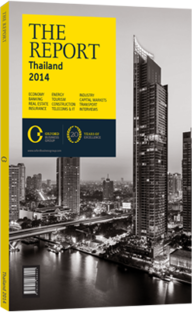A shift in focus: Major changes are expected for the advertising sector in the year ahead
Underlying a country’s advertising expenditure (adex) is usually the wider picture of macroeconomic growth, with Thailand no exception to this rule. Thus, during recent years of GDP expansion, rising incomes translated into greater expenditure. According to Maybank Kim Eng, advertising spend demonstrated a compound annual growth rate of 6.2% between 1995 and 2012.
In recent times, however, the slowdown in GDP growth has had an effect, and this is likely to continue in 2014. In addition, the expected arrival of many more TV channels through digital TV licensing may also spread existing budgets thinner, and heightened competition may result in reductions on rate cards. The advertising sector thus faces some major changes in the year ahead. Indeed, certain shifts in the type of platforms used and the types of ads run are already occurring, as advertisers seek to maximise the return from their media investments.
Spenders
Recording an average 4.3% growth rate over the past decade, Thailand’s GDP totalled $366bn in 2012, with a GDP per capita of $5168. In 2013 growth slowed, with GDP rising just 0.6% in the last quarter from a year earlier, according to the National Economic and Social Development Board. The expansion was the smallest since the first quarter of 2012.
At the same time, household debt has been swelling, reaching around 80% of GDP by the third quarter of 2013. There are several factors behind this – not the least being the government’s first-car buyer’s scheme of 2012, which boosted car sales, but often did so via car loans that Thais now have to pay back. This has further suppressed spending power and consumer confidence, and naturally also has follow-on effects for the advertising industry. The latest Nielsen figures available show that total ad spending in 2013 grew by just 0.95% to BT115bn ($3.76bn) from BT113.9bn ($3.72bn) in 2012. The economic downturn has likely hit the small and medium-sized enterprises harder than the larger companies, in terms of advertising budgets. This can be seen in the figures for ad spend by the top-10 advertisers. Nielsen reported a drop in adex in first 11 months of 2013 by Procter & Gamble (Thailand) and L’Oreal (Thailand), while other top advertisers Unilever (Thai) Holdings, Toyota Motor Thailand, Beiersdorf (Thailand), Coca-Cola (Thailand), Total Access Communication, Advanced Info Service, Real Move and the Prime Minister’s Office kept spending. The overall decline in adex has therefore likely been mainly concentrated outside the top 10. The sector breakdown among the top 10 above is typical of the main adex industries: cosmetics and pharmaceuticals, automotive, food and beverages, and information and communications technology. Government advertising can also be significant.
Proven Media
One of the ways in which advertisers are responding to the downturn in consumer spending is by focusing adex on proven mediums – TV adex, for example, continues to grow, up 1.68% in 2013 – and by switching to more direct promotion in-store.
This gives a more immediate impact, with cosmetics, food and beverage, and other consumer goods firms now often visible at a kiosk in the local supermarket.
Another big gainer has been transit. Advertising to consumers on in-carriage TVs as they commute on Bangkok’s popular BTS and MRT trains has proven popular, with transit advertising rising 18.65% in 2013.
Advertisers are thus moving their money to mediums with stronger immediate impact, while retaining the nationwide channel of TV as the main platform.
This means agencies – and all the major international players are present in Thailand, via local Thai outfits, alongside many Thai companies – are also having to shift their focus, taking account of the reduced spending power of many consumers. This may also impact some of the second-tier media outlets, which do not have the audience reach of the big players.
With advertisers seeking to maximise returns, the tendency may be towards further concentration of adex with networks that can guarantee the widest possible coverage. It looks like some competitive times are ahead then for Thailand’s advertising sector.
You have reached the limit of premium articles you can view for free.
Choose from the options below to purchase print or digital editions of our Reports. You can also purchase a website subscription giving you unlimited access to all of our Reports online for 12 months.
If you have already purchased this Report or have a website subscription, please login to continue.

